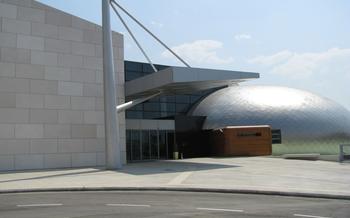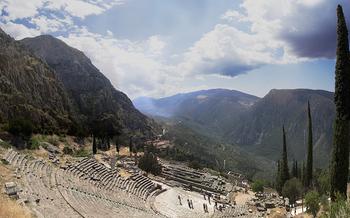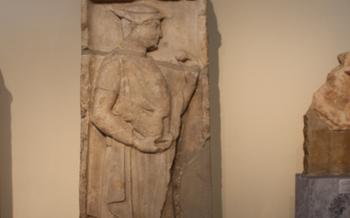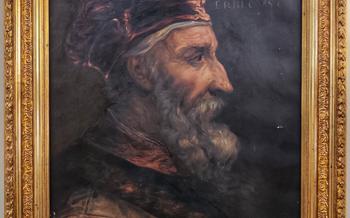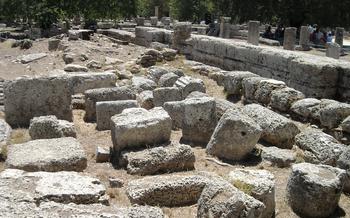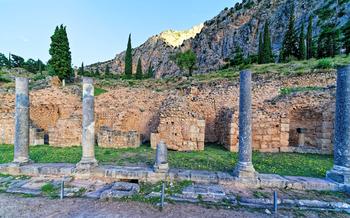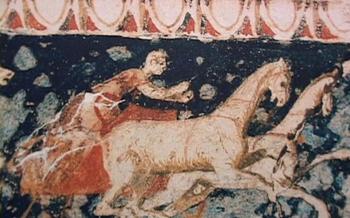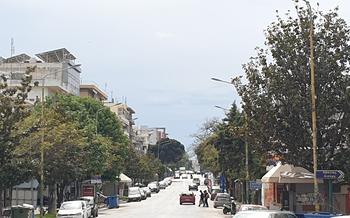
The Archaeological Museum of Aigion
- Overview
- Exploring the Galleries
- The Roman Baths: A Luxurious Retreat
- Sculptures and Statues: Masterpieces of Antiquity
- The Hellenistic Period: A Time of Cultural Exchange
- The Roman Period: Aigion Under Roman Rule
- The Early Christian Period: A New Era Begins
- The Byzantine Period: A Legacy of Art and Architecture
- The Ottoman Period: A Time of Change and Adaptation
- The War of Independence: Aigion's Role in the Struggle
- The Archaeological Museum Today: A Center for Learning and Discovery
- Insider Tip: Unveiling Hidden Gems
Overview
Nestled in the picturesque town of Aigion, in the heart of Greece's Peloponnese region, lies the Archaeological Museum of Aigion, a treasure trove of ancient artifacts that narrate the captivating story of this region's rich history and cultural heritage. Established in 1899, the museum houses a remarkable collection of antiquities unearthed during archaeological excavations conducted in and around the ancient city of Aigion, offering visitors an immersive journey through the ages.
Situated in the city center, the museum occupies a beautifully restored neoclassical building that was once the residence of a prominent local family. Its elegant facade and spacious interior provide an ideal setting for showcasing the diverse artifacts that bring Aigion's past to life. The museum's mission is to preserve, study, and present the archaeological heritage of Aigion and its surrounding area, promoting a deeper understanding and appreciation of the region's cultural legacy.
Exploring the Galleries
The Archaeological Museum of Aigion houses its diverse collection in thematically organized galleries, each dedicated to a specific historical period or aspect of ancient life. Visitors are taken on a chronological journey through time, starting from the prehistoric era and continuing through the Hellenistic, Roman, Early Christian, Byzantine, and Ottoman periods.
Highlights from Different Historical Periods
The museum's exhibits showcase a wide range of artifacts from different historical periods, providing a glimpse into the rich cultural heritage of Aigion. Among the highlights are:
-
Prehistoric tools and pottery from the Neolithic and Bronze Age, offering insights into the earliest settlements in the region.
-
Geometric and Archaic period pottery, beautifully decorated with intricate patterns and mythological scenes.
-
Classical and Hellenistic sculptures, including marble statues of gods, heroes, and mythological creatures, showcasing the artistic prowess of ancient Greek sculptors.
-
Roman mosaics and wall paintings, depicting scenes from mythology, daily life, and religious practices, providing a glimpse into the opulent lifestyle of the Roman elite.
-
Early Christian symbols and artifacts, such as crosses, lamps, and inscriptions, témoigner to the rise of Christianity in the region.
-
Byzantine icons and frescoes, beautifully preserved and depicting religious scenes and figures, showcasing the artistic and spiritual traditions of the Byzantine Empire.
-
Ottoman pottery, jewelry, and weapons, reflecting the cultural influences of the Ottoman Empire and the coexistence of different cultures in the region.
Interactive Displays and Educational Resources
The museum enhances the visitor experience through interactive displays and educational resources that bring history to life. Touchscreens, multimedia presentations, and hands-on activities engage visitors of all ages, allowing them to explore the museum's collection in a fun and interactive way.
Temporary Exhibitions and Special Events
In addition to its permanent collection, the Archaeological Museum of Aigion regularly hosts temporary exhibitions and special events that focus on specific themes or historical periods. These exhibitions often feature new discoveries, rare artifacts, and collaborations with other museums and institutions, providing visitors with a fresh perspective on ancient Aigion and its rich history.
The Roman Baths: A Luxurious Retreat
Amidst the captivating exhibits of the Archaeological Museum of Aigion, the Roman baths stand as a testament to the city's opulence and embrace of Roman culture. Step into this well-preserved bathing complex and marvel at the architectural prowess of the ancient Romans. Constructed using stone and brick, the baths feature vaulted ceilings, arched doorways, and intricate mosaics that adorn the floors and walls.
The centerpiece of the complex is the frigidarium, a large, rectangular pool filled with cool water. Bathers would start their bathing ritual here, immersing themselves in the refreshing waters to cleanse and invigorate their bodies. The frigidarium also served as a gathering place for social interaction and conversation.
Adjacent to the frigidarium lies the tepidarium, a moderately warm room that prepared bathers for the intense heat of the caldarium. Here, they would relax and soak in the warm water, allowing their muscles to loosen and their pores to open.
The caldarium, the hottest room in the bath complex, was the ultimate destination for a Roman bath. With temperatures reaching up to 40 degrees Celsius, the caldarium offered a deeply therapeutic and invigorating experience. Bathers would sweat profusely, releasing toxins and impurities from their bodies.
To enhance the bathing experience, the Romans employed various techniques. They used strigils, curved metal scrapers, to remove dirt and sweat from their skin. They also applied scented oils and perfumes to their bodies, leaving them feeling refreshed and rejuvenated.
The Roman baths were not merely places of hygiene but also centers of social and cultural exchange. Romans of all walks of life frequented the baths, using them as venues for socializing, networking, and discussing politics, philosophy, and the latest news.
The Roman baths in Aigion offer a glimpse into the luxurious lifestyle and sophisticated bathing culture of the Roman Empire. They stand as a testament to the city's prosperity and its embrace of Roman customs and traditions.
Sculptures and Statues: Masterpieces of Antiquity
Among the treasures of the Archaeological Museum of Aigion, the collection of sculptures and statues stands out as a testament to the artistic prowess of ancient Greek sculptors. These masterpieces, carved from marble, bronze, and other materials, depict gods, heroes, mythological creatures, and scenes from everyday life with remarkable detail and expressiveness.
One of the highlights of the collection is a stunning marble statue of Aphrodite, the goddess of love and beauty. The statue showcases the goddess's graceful form and serene expression, capturing her divine essence in stone. The intricate details of her flowing drapery and delicate features reveal the sculptor's mastery of anatomy and craftsmanship.
Another notable piece is a bronze statue of Hermes, the messenger of the gods. The statue portrays Hermes in motion, with his winged sandals and caduceus, the symbol of his role as a divine messenger. The dynamic pose and expressive features of the statue convey a sense of urgency and purpose, capturing Hermes's role as a swift and agile intermediary between the gods and mortals.
The museum also boasts a collection of kouroi, or archaic Greek statues of young men. These statues, often depicted in a rigid, frontal pose with a serene expression, provide valuable insights into the artistic conventions and religious beliefs of ancient Greece. The kouroi serve as reminders of the early stages of Greek sculpture and the development of the human form in art.
In addition to these iconic sculptures, the museum houses a variety of other statues and statuettes from different periods, including Roman busts, Hellenistic figurines, and Byzantine religious icons. These works of art offer a glimpse into the diverse artistic styles and influences that have shaped Aigion's history and culture over the centuries.
The Hellenistic Period: A Time of Cultural Exchange
The Hellenistic period, which lasted from the death of Alexander the Great in 323 BC to the Roman conquest of Greece in 146 BC, was a time of profound cultural exchange and transformation in the Mediterranean world. Alexander's conquests opened up new trade routes and facilitated the spread of Greek culture and ideas throughout his vast empire.
In Aigion, the Hellenistic period was marked by a flourishing of art and architecture. The city became a center of learning and culture, attracting scholars, artists, and philosophers from across the Hellenistic world. The influence of Hellenistic art can be seen in the sculptures, mosaics, and other artifacts found in the Archaeological Museum of Aigion.
One of the most notable examples of Hellenistic art in the museum is a bronze statue of Hermes, the Greek god of travelers and merchants. The statue, which dates to the 3rd century BC, depicts Hermes with his characteristic winged sandals and petasos (hat). The statue is a fine example of the naturalistic style of Hellenistic sculpture, which sought to capture the individual characteristics of the human form.
Another highlight of the museum's Hellenistic collection is a mosaic floor from a wealthy villa in the city. The mosaic depicts scenes from Greek mythology, including the birth of Athena and the battle between the gods and the giants. The mosaic is a testament to the skill and artistry of Hellenistic craftsmen.
The Hellenistic period was a time of great prosperity and cultural exchange for Aigion. The city's strategic location on the Gulf of Corinth made it a major trading center, and its vibrant cultural life attracted visitors from all over the Mediterranean world. The Archaeological Museum of Aigion offers a glimpse into this fascinating period of the city's history.
The Roman Period: Aigion Under Roman Rule
The Roman conquest of Greece in 146 BC marked a significant turning point in Aigion's history. The city became part of the Roman province of Achaia and experienced a period of relative peace and prosperity under Roman rule. The Romans introduced their own administrative structures and urban planning, leaving a lasting impact on the city's development.
One of the most notable Roman legacies in Aigion is the construction of an impressive complex of public baths. These baths, known as the Roman Baths, featured intricate mosaic floors, elegant wall paintings, and a variety of bathing facilities. The baths served as a place for relaxation, socialization, and hygiene, reflecting the Romans' emphasis on public health and well-being.
The Roman period also witnessed the integration of Roman customs and traditions into Aigion's society. The city's elite adopted Roman dress, hairstyles, and dining habits, while Roman religious cults and festivals were introduced. This cultural exchange led to a gradual assimilation of Roman values and practices into the local culture.
Evidence of Roman rule can be found throughout the Archaeological Museum of Aigion. The museum's collection includes numerous artifacts from this period, such as Roman coins, pottery, and sculptures. These objects provide valuable insights into the daily life, economy, and artistic traditions of Aigion under Roman rule.
The Early Christian Period: A New Era Begins
The rise of Christianity in the Roman Empire marked a significant turning point in the history of Aigion, as it did for many other cities across the Mediterranean. With the Edict of Milan in 313 AD, Christianity was granted official toleration, leading to the transformation of Aigion into a prominent Christian center.
The Archaeological Museum of Aigion houses a rich collection of artifacts that shed light on this transformative period. Among the notable exhibits are early Christian symbols, such as the chi-rho monogram, which represents the first two letters of the Greek word for Christ. These symbols were often used to decorate buildings and objects, serving as a visual expression of the Christian faith.
Other artifacts from the early Christian period include pottery and glassware decorated with Christian motifs, as well as lamps bearing the images of saints or scenes from the Bible. These objects provide a glimpse into the daily lives and rituals of the early Christian community in Aigion.
The impact of Christianity on Aigion's urban landscape can be seen in the construction of churches and other religious structures. The remains of several early Christian basilicas have been discovered in the city, indicating the growing importance of Christianity as a civic and social force.
The Archaeological Museum of Aigion offers visitors a unique opportunity to explore the rich heritage of the early Christian period in Aigion, providing insights into the beliefs, practices, and daily lives of the city's early Christian community.
The Byzantine Period: A Legacy of Art and Architecture
The Byzantine Empire, with its capital in Constantinople, ruled Greece for over a millennium, leaving a significant imprint on the country's culture, art, and architecture. Aigion, like many other Greek cities, embraced Byzantine traditions and became a center of Byzantine art and architecture.
During the Byzantine period, Aigion witnessed the construction of numerous churches and monasteries, many of which have survived to this day. These religious buildings showcase the distinctive Byzantine architectural style, characterized by intricate brickwork, domed roofs, and elaborate mosaics and frescoes.
One of the most notable examples of Byzantine architecture in Aigion is the Church of Panagia Trypiti, built in the 13th century. This beautifully preserved church features stunning mosaics depicting biblical scenes and saints, as well as intricate carvings and sculptures.
The Byzantine period also saw the development of a unique style of iconography, which depicted religious figures in a stylized and symbolic manner. Icons, which were often used for devotional purposes, were widely produced and venerated in Aigion during this time.
The Archaeological Museum of Aigion houses a collection of Byzantine artifacts, including icons, mosaics, and architectural fragments, which provide a glimpse into the city's rich Byzantine heritage. These artifacts showcase the artistic achievements of the Byzantine period and offer insights into the religious and cultural life of Aigion during this era.
The Ottoman Period: A Time of Change and Adaptation
The Ottoman conquest of Greece in the 15th century marked a significant turning point in Aigion's history. The city, like the rest of Greece, came under the rule of the Ottoman Empire, which brought about both challenges and opportunities for its inhabitants.
The Ottomans implemented administrative policies that allowed for religious tolerance, enabling the Greek Orthodox Church to continue functioning relatively freely. This allowed for the preservation of many Byzantine churches and monasteries in Aigion, some of which still stand today.
Cultural exchanges between Greeks and Ottomans occurred during this period, leading to the adoption of certain Ottoman customs and traditions by the local population. This resulted in a unique blend of Greek and Ottoman influences in Aigion's architecture and way of life.
Despite the challenges posed by Ottoman rule, Aigion managed to maintain its cultural identity and adapt to the new circumstances. The city's resilience and ability to thrive under different rulers are reflected in the artifacts and exhibits from this period displayed in the Archaeological Museum of Aigion.
The War of Independence: Aigion's Role in the Struggle
Aigion played a significant role in the Greek War of Independence against the Ottoman Empire, which took place from 1821 to 182The city's strategic location on the Gulf of Corinth made it a key battleground during the conflict. In 1821, Greek rebels captured Aigion and used it as a base for operations against the Ottomans. The city was retaken by the Ottomans in 1825, but the Greeks regained control in 182
Aigion's contribution to the Greek War of Independence is commemorated in the Archaeological Museum of Aigion. The museum's exhibits include weapons, uniforms, and other artifacts from the war. There are also displays on the battles that took place in and around the city, as well as the role of Aigion's citizens in the struggle for independence.
One of the most poignant exhibits in the museum is a painting depicting the Battle of Aigion, which took place in 182The painting shows Greek soldiers fighting bravely against the Ottoman forces. The battle was a victory for the Greeks, and it helped to secure the independence of Greece.
The Archaeological Museum of Aigion is a valuable resource for learning about the city's role in the Greek War of Independence. The museum's exhibits provide a glimpse into the courage and determination of the Greek people who fought for their freedom.
The Archaeological Museum Today: A Center for Learning and Discovery
The Archaeological Museum of Aigion has evolved into a vibrant center for learning and discovery, playing a crucial role in preserving and showcasing the rich history of the region. The museum's educational programs and workshops provide visitors with opportunities to engage with the past in a hands-on and interactive manner. These programs are designed to appeal to a wide range of audiences, including school children, families, and history enthusiasts. The museum's staff is actively involved in research and publications, continuously expanding our understanding of Aigion's past. They collaborate with other institutions and organizations to promote cultural exchange and foster a deeper appreciation for the region's heritage.
The Archaeological Museum of Aigion stands as a testament to the enduring legacy of this ancient city. Through its comprehensive collection, engaging exhibits, and educational programs, the museum invites visitors to embark on a journey through time, uncovering the secrets of Aigion's storied past. Whether you are a history buff, an art lover, or simply curious about the roots of Greek civilization, a visit to the Archaeological Museum of Aigion promises to be a rewarding and unforgettable experience.
Insider Tip: Unveiling Hidden Gems
For those seeking hidden treasures, the Archaeological Museum of Aigion offers a few surprises. In an unassuming corner, you'll find a small but exquisite collection of ancient jewelry, including delicate gold earrings, intricate necklaces, and sparkling gemstones. These adornments once adorned the bodies of Aigion's wealthy and fashionable residents.
Another hidden gem lies in the form of a small, unassuming statue tucked away in a side gallery. This enigmatic figure, known as the "Lady of Aigion," is believed to date back to the 4th century BC. Its simple yet elegant lines and serene expression have captured the hearts of many visitors.
If you're a photography enthusiast, be sure to bring your camera. The museum's well-lit galleries and artifacts provide ample opportunities for capturing stunning images. Experiment with different angles and lighting to capture the beauty and essence of these ancient treasures.
After exploring the museum, take a moment to wander through the charming town of Aigion. Its narrow streets, traditional houses, and bustling markets offer a glimpse into the town's rich history and vibrant present. Enjoy a leisurely lunch at a local taverna, savoring the flavors of traditional Greek cuisine.
With its hidden gems, captivating exhibits, and picturesque surroundings, the Archaeological Museum of Aigion is a must-visit destination for anyone interested in ancient history, culture, and art. So, take your time, explore every nook and cranny, and uncover the treasures that await you within its walls.
